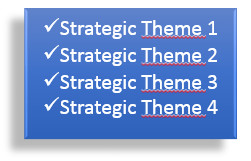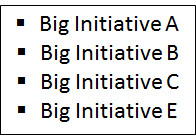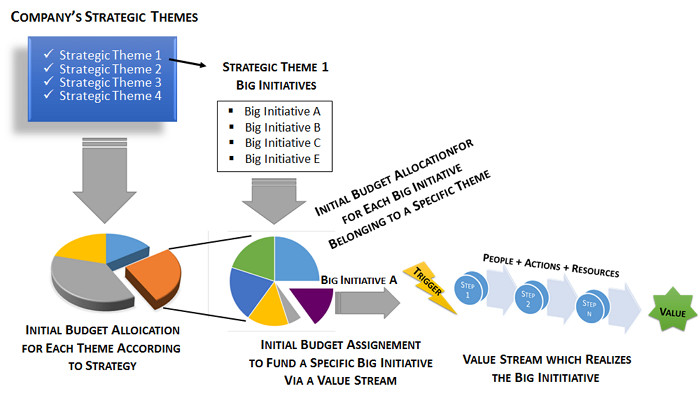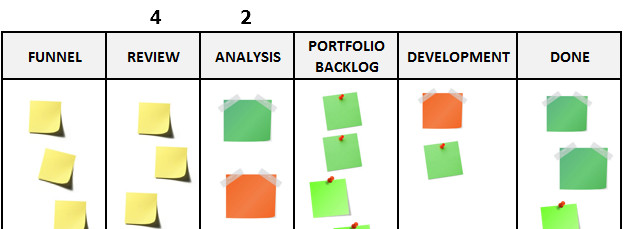In my previous post I explained some of the foundemantals steps for implementing an Agile and Lean Portfolio Management. Want to know how actually strategy drives execution of company Big Initiatives, through Agile and Lean?!
In my previous post I wrote why Agile/Lean Values and Principles are the most critical point to start with, also for Portfolio Management; then I proceeded explaining what are Values Streams and how they drive the whole portfolio development. Going further, I wrote about prioritization through Cost of Delay (COD) and Weighted Shortest Job First (WSJF) and finally proposed a possibile process for portfolio management and the related kanban board.
In this post I would like to explore how strategy is bridged with execution, and how Lean and Agile together create the most effective approach to avoid waste, remain adaptive and deliver value rapidly.
Bridging Strategy with Execution
Strategic Themes
Fine. The journey starts when top management decides what will be the company strategy for the next year/s (1? 3? 5?). Usually this phase produces a list of Strategic Themes the company should pursue. Every strategic theme has at least a title, a description and obviously expected benefits.

Examples of Strategic themes’ titles a compay could have: Attract younger people (e.g. Millennials), Digitalize 80% of Company Internal Processes, Redesign the user experience for retail customers, etc.
Then, a first budget allocation is made, dedicating slices of overall budget, for each strategic theme.
Big Initiatives & Value Streams
Well, now it’s time to identify the list of Big Initiatives that realize the expected value for each Strategic Theme: One Strategic Theme -> Many Big Initiatives.

Then, for each Big Initiative, a high level “analysis” (Agile Feasibility, not Big Analysis Up Front!) is executed, which explores the vision, benefits, raw cost estimation (teams involved, necessary resources), etc, of the initiative itself.
This step is represented in the Portfolio kanban board by the column Analysis (previous post here).
Usually I conduct that high level Analysis or Agile Feasibility, by using the DAD Inception Phase. I wrote about this in one of my previous post here: “Getting a big and complex project off, from the starting blocks with Agile (DAD Inception)“.
Then, people and teams involved, sequence of actions, usage of resources, knwoledge and expertise, represent, all together, the Value Stream through which pursue and deliver expected value: from concept (trigger) to cash (value).

Now it’s time to fund the initiatives. A budget is allocated (and dedicated) for each Value Stream. The picture below puts everything together.

One important piece of news, is that the Agile iterative and Inspect/Adapt approaches are also used for Budget Allocation. Actually budgets, for strategic themes and value streams, are initially allocated as usual, but they are revised at least every quarter. What does it mean?
It means for example that the overall budget allocated for a specific Strategic Theme, is decomposed in slices and assigned to belonging value streams. Then, according to effective progress and results of each value stream, and eventual market change, every quarter budgets could be revised and re-balanced beteween the value streams belonging to that strategic theme. The Portfolio Management team is responsible to autonomously rearrange budget at quarter boundaries,
Flavors of Lean in Portfolio Management
Lean is key to Portfolio Management.
It helps to reduce waste, decrease time-to-market, and drastically improve quality thanks to Pull System and concepts like JIT and WIP Limiting.
A Pull System provides that development or production should be ‘pulled through’ rather than ‘pushed through’ the productive system
Systems like those, are literally driven by customer requests and thus worked just in time, as productive capacity is available. This assures that the companies adopting these systems, to produce what is strictly necessary and actually requested by the market/customers,
Another foundamental gear of a pull system is Just-In-Time (JIT) concept.
In lean manufacturing JIT means producing and delivering finished goods ‘just in time’ , right before being sold, just enough to meet current demand.
It means for Portfolio Management that a new phase of the process won’t start before the previous one is triggered and finished and, furthermore, that work will happen according to available capacity and customer demand.
A final important concept necessary to implement an effective pull system, is WIP Limit. WIP is an acronym which stands for “work in progress”.
Limiting WIP is a strategy for preventing bottlenecks, avoid over-production, avoid waiting times and it generally improves flow by creating a steady pace between the production phases.
Let’s see now how the concepts above mentioned, are applied to Portfolio Management. A usual portfolio process and relative kanban board is like this one:

New initiatives or ideas arrive in the Funnel. I usually use this lean canvas which summarizes basic information that finally represents the card in the kanban board:

The subsequent phase Review, is meant to review, refine a bit and validate the basic information, figures and facts of each item in the funnel, assigning a first piority. New relevant information are reported also in the card, stressing another lean concept (Visual Management), in order to facilitate visualization and immediate understanding.

In order to avoid too much analysis, this phase is also executed in an Agile manner (using Scrum), collaboratively and doing not much Analysis. The final outcome is a Lightweight Business Case which reports the main assumptions and results. I use the one from Scaled Agile Framework you can download here: SAFe Lightweight Business Case.
JIT conecpt is here applied because the information of every initiative, starting from the Funnel up until Analysis columns, is deepened incrementally according to customer needs (what arrived in the Funnel) and the effective capacity available.
Nothing is worked preventively and stays parked somewhere waiting for something to happen.
Ok, but what about WIP Limit? Well, in Portfolio Management we want to limit WIP because letting initiatives proceed through the kanban system is costly. This is why the Review and, moreover, Analysis columns are WIP Limited.
The Review phase is definitely lighter than Analysis. Usually the review is done by the portfolio management team plus some SME (Subject Matter Experts) and it does not last more than hours. Analysis could last days (for some very big programs even weeks), and it is more resource consuming. This is the reason we want to WIP limit more the latter.
Yes, now you should be ready to reason about prioritization through WSJF, GO/NOGO decisions, management of Portfolio Backlog and finally how to match capacity with demand when it’s time for initiative to be pulled into development….but these topics will be covered in next posts.
Enjoy! 🙂




